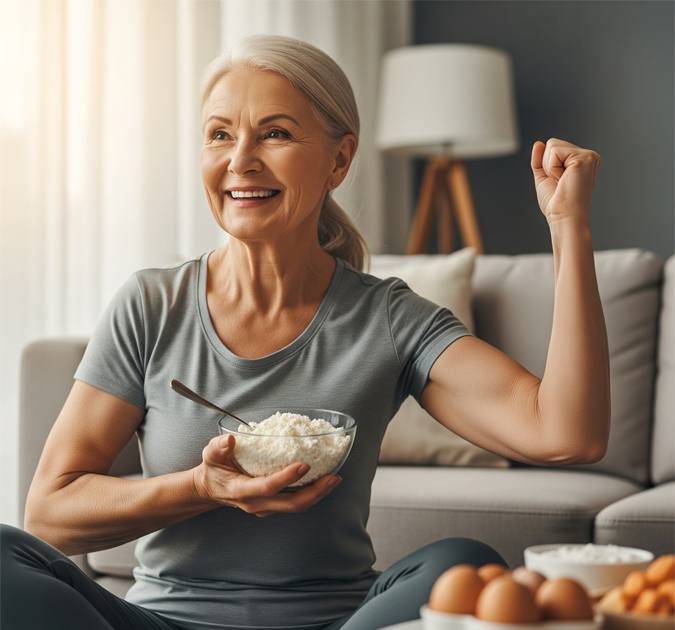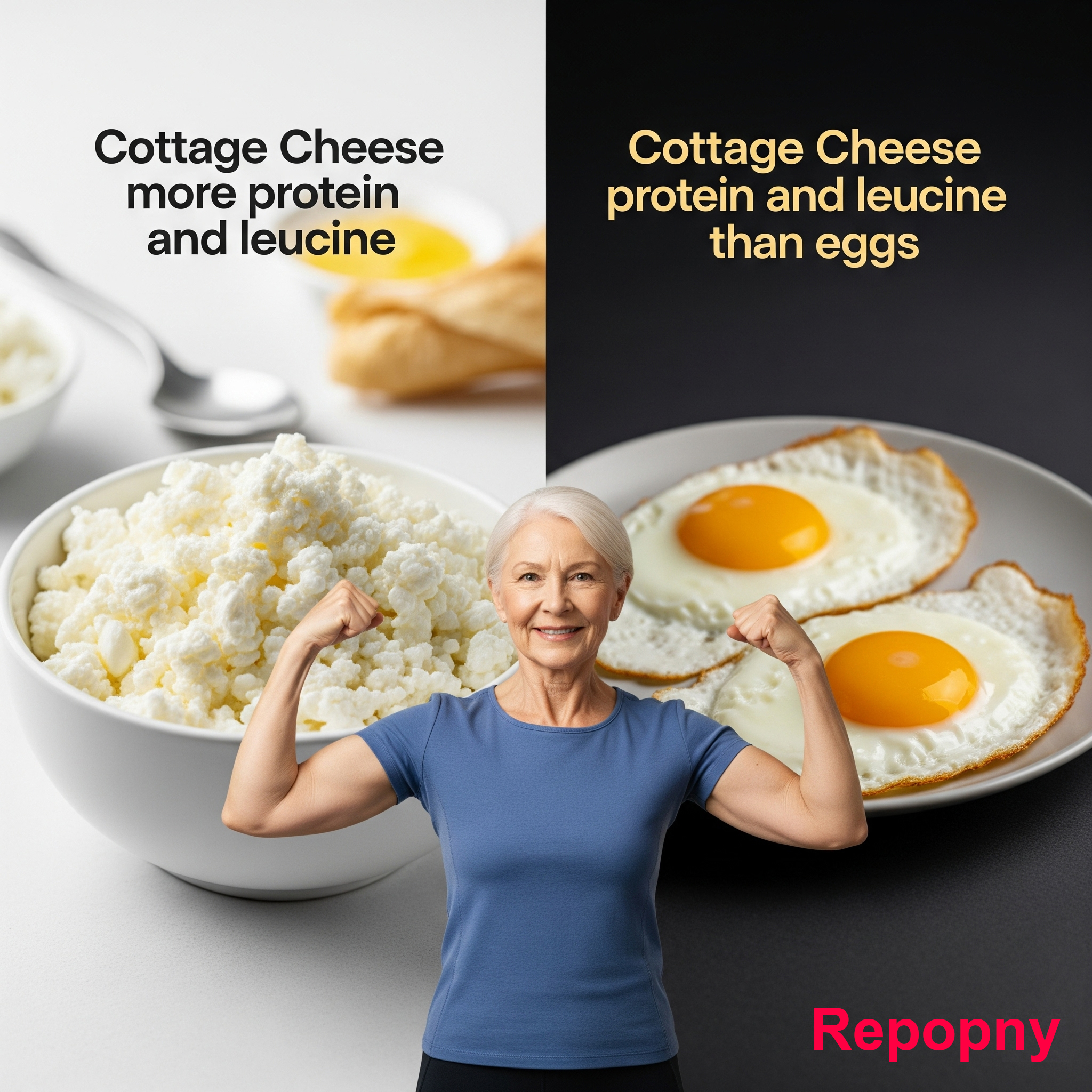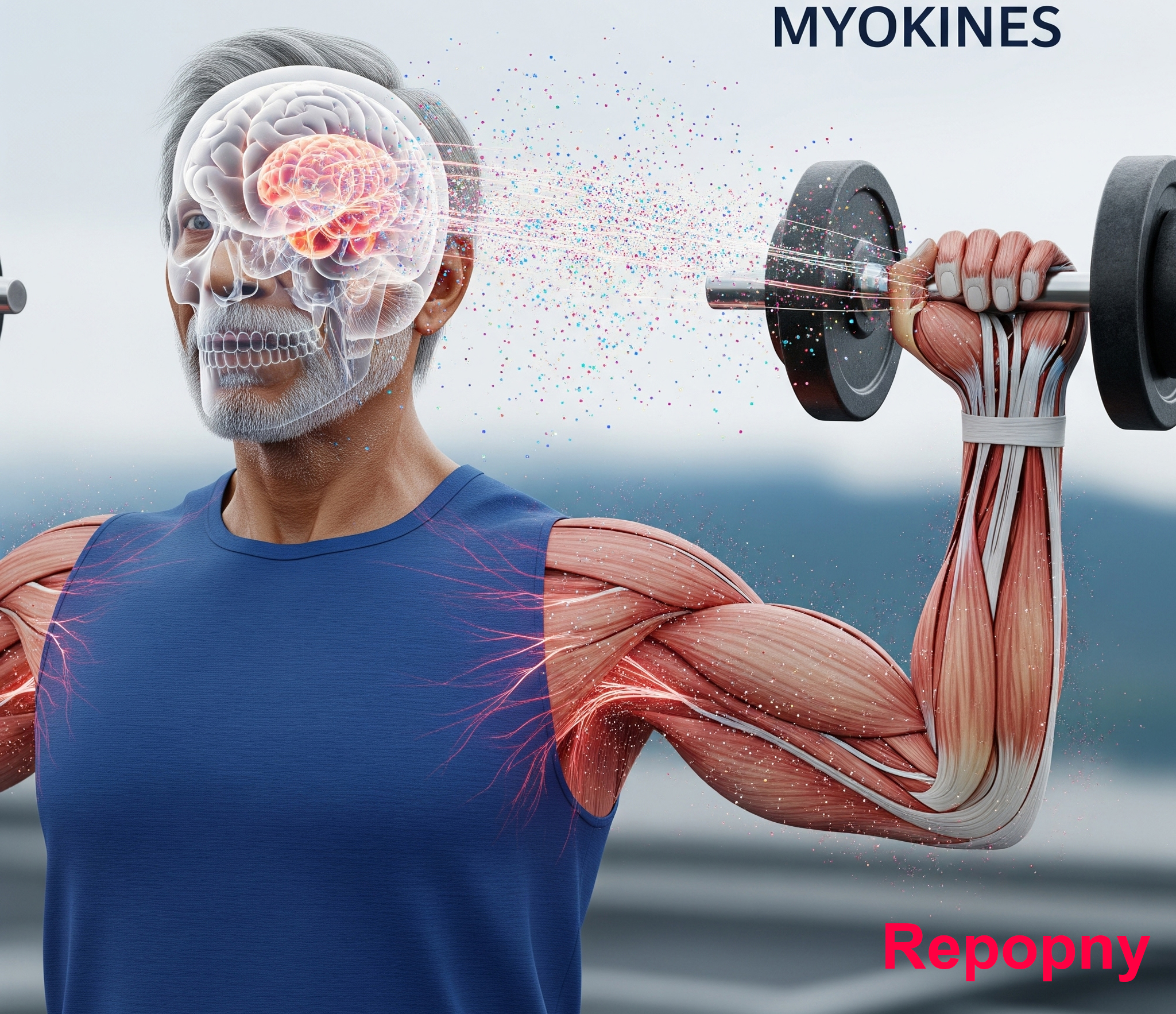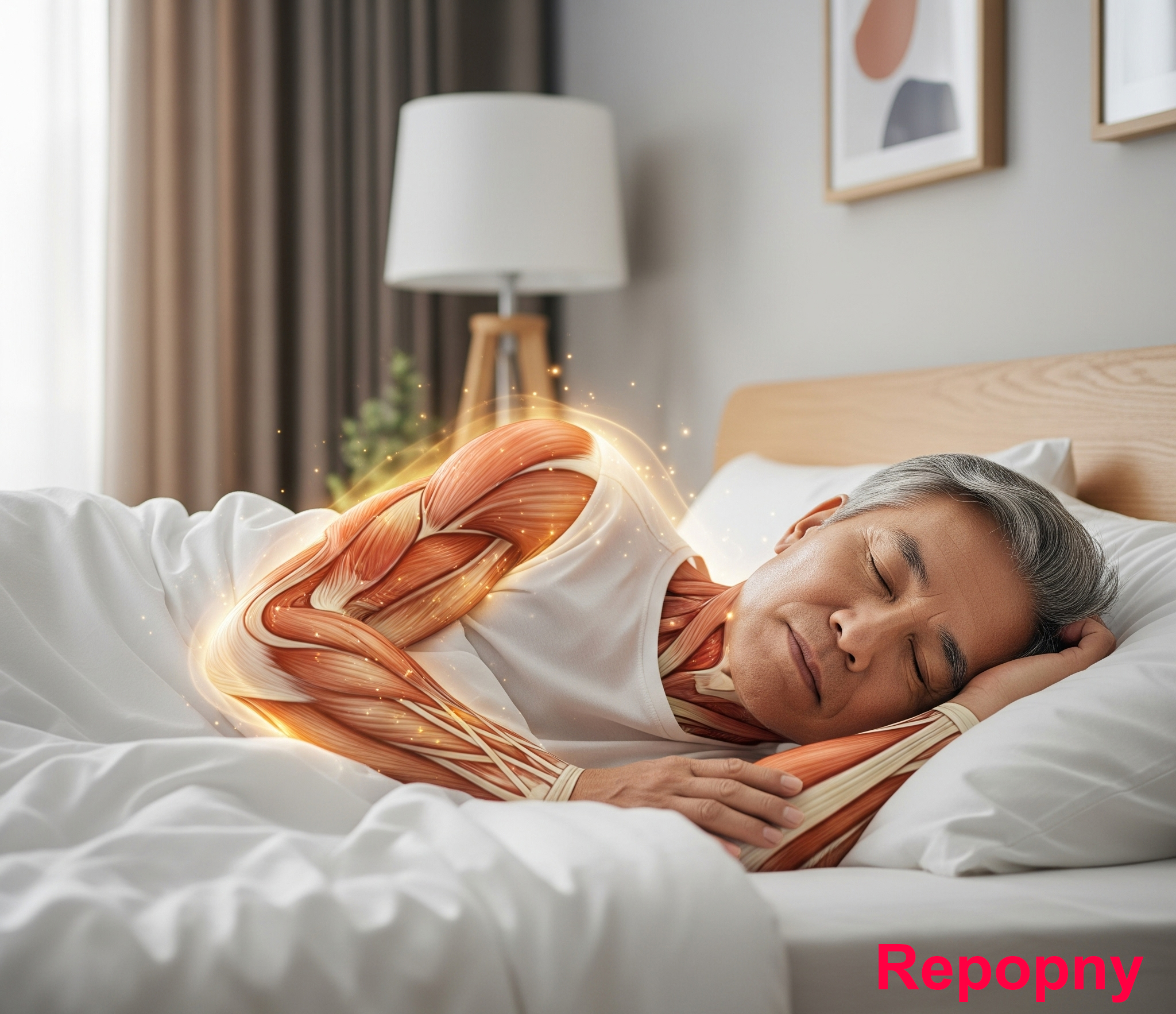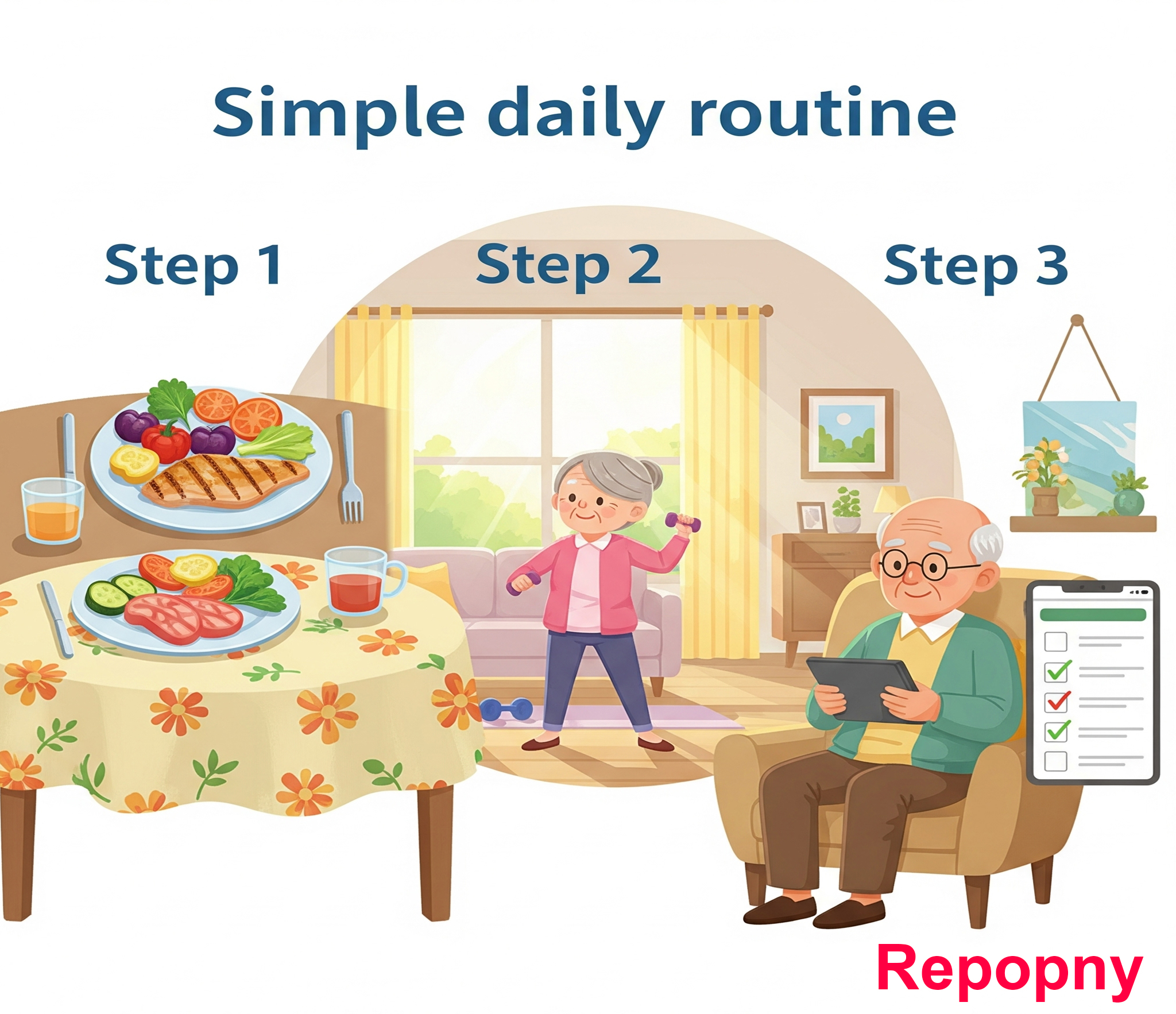Contents
- 1 Introduction: Unlocking Muscle Strength for Senior Health
- 2 Discovery 1: The Surprising Power of Cottage Cheese – A Superfood for Senior Muscle Health
- 3 Discovery 2: Leucine – The Master Switch for Senior Muscle Growth
- 4 Discovery 3: Understanding Satiety Signals – Preventing Muscle Undernutrition in Seniors
- 5 Discovery 4: The Brain-Muscle Connection: Fueling Senior Vitality and Strength
- 6 Discovery 5: Sleep and Muscle: Protecting Senior Strength While You Rest
- 7 Discovery 6: A 3-Step Daily Routine to Defeat Sarcopenia for Seniors
Introduction: Unlocking Muscle Strength for Senior Health
Maintaining senior health and vitality often hinges on robust muscle strength. While many consider eggs a protein powerhouse, a surprising superfood actually offers more protein per gram, actively combating sarcopenia and supporting graceful aging – a key aspect of older adult wellness. Research indicates muscle loss can begin as early as your 30s, with many losing significant mass by 60 without realizing it.
The good news? Your muscles are always listening, reacting to your movements, diet, and even sleep. Some foods send stronger anabolic (muscle-building) signals. We’re about to explore one of the most potent high-protein foods – often overlooked, it provides more usable protein and leucine than eggs, with faster absorption. More importantly, you’ll learn how to effectively integrate it into your senior diet.
Why is Maintaining Muscle Mass So Important for Healthy Aging?
Muscle isn’t just about strength or appearance. It’s the body’s most metabolically active tissue, preserving bones and joints, controlling insulin sensitivity, and profoundly impacting your brain. There’s a strong correlation between cognitive lifespan and muscle mass. Studies suggest older adults with greater muscle preservation often have superior cognition, a decreased dementia risk, and better emotional control.
Why? Muscles are hormone storehouses. Myokines, tiny proteins released during movement, communicate with the brain, lower inflammation, and promote neuroplasticity. So, if you’re feeling weaker, more fatigued, or seeing the scale rise, sarcopenia might be subtly developing. But we can intervene with science-backed senior nutrition and targeted exercise, steering clear of complex supplements or grueling workout regimens.
In this article, we’ll delve into six groundbreaking discoveries from nutritional physiology and neurology. Each offers practical skills to slow and even reverse muscle loss in seniors through simple behavioral adjustments and natural eating techniques, boosting overall senior well-being.
Discovery 1: The Surprising Power of Cottage Cheese – A Superfood for Senior Muscle Health
Ever weighed 100g of cottage cheese versus 100g of eggs? You might be surprised. In terms of usable protein and anabolic potential, cottage cheese doesn’t just compete with eggs; it often surpasses them, making it an excellent protein source for seniors.
What Does the Research Reveal About this Elder Health Staple?
A study evaluating complete meals found non-liquid dairy products like cottage cheese consistently and significantly improved muscle growth and strength in persons over 50, even more so than eggs or salmon. This highlights its potential for healthy aging.
A large egg contains about 0.5g of leucine. In contrast, 100g of cottage cheese provides approximately 11g of protein and 1.3g of leucine. Leucine, an essential amino acid, is the crucial “switch” for muscle protein synthesis. This is huge for senior strength.
Why is Leucine So Important for Older Adults?
Leucine and total protein content dictate your muscles’ response strength. Aging bodies experience anabolic resistance, meaning they need more stimulation to build muscle. Experts recommend older adults consume 25-30g of protein and 3g of leucine per meal to promote muscle protein synthesis. Cottage cheese stands out as an effective whole-food option to meet these goals, offering substantial complete protein and that vital 1.3g of leucine per serving.
Cottage cheese is rich in casein, a slow-digesting milk protein that acts like a time-release capsule, providing a steady amino acid supply for 3-4 hours. Unlike fast-absorbing proteins like whey, muscles need this gradual drip, especially overnight when fasting blood amino acids decrease. A 2011 trial on older individuals showed casein intake before bed resulted in favorable overnight whole-body protein balance. Similarly, young men consuming 40g of casein pre-bed enhanced muscle synthesis and overnight protein absorption. These benefits for senior health can be achieved without powders, using whole foods like cottage cheese.
Eggs offer a quick metabolic spark, but cottage cheese burns slowly, sustaining your muscles longer.
How to Use Cottage Cheese Effectively in Your Senior Diet:
For effective protein intake for seniors, consume 150g (2-3 cups) of low-fat cottage cheese as a pre-dinner or evening snack, providing ~16g protein and ~2g leucine. For older adults with anabolic resistance, aim for 200-250g to get ~25-28g protein and ~3g leucine per serving. This strategy boosts both muscle gain and overall senior well-being.
Ever woken up starving, feeling weak? It might be your muscles, not your stomach, calling. Choosing pre-sleep cottage cheese helps prepare your muscles for nighttime repair, shifting your metabolism from breakdown to rebuilding – a simple yet powerful step for healthy aging.
Discovery 2: Leucine – The Master Switch for Senior Muscle Growth
Consider your muscle cells a valuable factory needing a master switch. mTOR is that switch, a protein kinase controlling protein synthesis, cell growth, and recovery – a central command center for muscle building. This is where leucine comes in.
Leucine is unique among amino acids. Upon entering your bloodstream, it attaches to sensors, signaling mTOR to begin production, thus activating MTC1 and initiating protein synthesis within muscle cells – crucial for senior strength.
Why Do Aging Bodies Need a Stronger Signal for Muscle Development?
Anabolic resistance means muscles lose sensitivity to normal stimuli as we age. The muscle factory produces, but lacks sufficient workers. We need a louder, clearer signal to compensate for optimal senior muscle health.
The leucine trigger hypothesis suggests a substantial leucine surge (~3g per meal) is needed to fully activate mTOR in older individuals. Research confirms that 2.8-3g of leucine with 25-30g of high-quality protein per meal optimizes muscle protein synthesis in aging individuals. Regular “leucine triggers” improved MPS, especially post-exercise, according to a comprehensive review in older adults. Conversely, lower leucine meals produce weak signals, insufficient for significant muscle growth.
Imagine your muscles as an orchestra. Protein supplies the instruments; leucine is the conductor and spotlight. Without that trigger, the orchestra remains silent.
A Simple Guideline for Optimal Protein Intake for Older Adults:
Aim for 25-30g of high-quality protein per meal, ensuring each meal contains 2.5-3g of leucine. This translates to ~100g lean meat, ~200g cottage cheese, or a palm-sized serving. If meals fall short, consider an optional 0.5-1g leucine boost.
For a behavioral strategy in your senior diet, use a visual template to plan meals:
- Lunch: Combine two breakfast portions, three eggs (~1.5g leucine), and Greek yogurt (adding ~3g).
- Dinner: 120g lean beef, turkey, fish, or chicken (usually ~3g leucine).
- Evening/Additional: Replicate lunch or add vegetables and cottage cheese.
Ever feel your muscles aren’t reacting after a gym session? It might be the signal your body receives, not the exercise. Studies show older persons taking leucine-enriched supplements (~3g leucine, ~20g protein) had higher muscle protein synthesis post-exercise. Even high-protein meals underperformed if they didn’t meet the leucine threshold. A thorough analysis revealed even small amounts of leucine (~3g) can elicit maximal MPS. Your secret weapon for senior health is smart, targeted leucine.
Discovery 3: Understanding Satiety Signals – Preventing Muscle Undernutrition in Seniors
Even after eating enough, do you feel sluggish mid-day? This week, try the “protein pause” tool to understand senior nutrition better.
What’s Happening in Your Brain and Body as You Age?
Satiety, or fullness, is primarily regulated by hormones like cholecystokinin and leptin, which tell your brain when to stop eating. However, these are more attuned to meal size and fat accumulation than to muscle growth. The brain’s signal threshold changes with age; you feel satisfied earlier, even if muscles haven’t received building blocks.
Simultaneously, anabolic resistance increases protein and signal strength needed for muscle growth. Yet, your meal might trigger satiety hormones before reaching that threshold. Your internal hunger meter is out of sync with your senior muscle health needs.
Research Indicates Muscle Undernutrition in Older Adults:
Senior muscles are consistently underfed because the fullness threshold is triggered at a lower dietary protein intake. Even with adequate total calories, this mismatch causes progressive muscle loss over weeks and months. Imagine filling two buckets with one hose: the first (your brain) fills, while the second (muscle protein production) remains dry, even if you think the first is full.
The “Protein Pause” Approach for Better Senior Nutrition:
An easy tool for healthy aging is the protein pause. After eating, reflect: “Have I met my muscle protein goal?” If your meal didn’t provide 25-30g protein and ~3g leucine, add a “protein mini-plate”—a small portion of cottage cheese, Greek yogurt, or lean meat.
For example:
- Lunch: Salad, one egg, sliced avocado (~12-15g protein)—fills hunger but is insufficient for muscle building. Add 100g Greek yogurt (~10g protein) + 50g almonds (~8g protein).
- Dinner: Fish and vegetables (~20g protein). Pause, then add 50g cottage cheese for another 6-8g.
This “protein pause” is a habit-forming cognitive technique. It slows autopilot eating, letting you assess and align your meal with senior muscle health needs. Without this pause, you might starve your muscles while eating for comfort. Since muscle tissue boosts brain clarity via myokine release, ignoring this can lead to weaker joints, less stable gait, decreased stress tolerance, and even cognitive decline – all impacting senior well-being.
The empowering reality is this can be fixed now. You’re simply adjusting internal sensors and meals to suit your muscle’s requirements for healthy aging.
Discovery 4: The Brain-Muscle Connection: Fueling Senior Vitality and Strength
It’s often said you are what you eat. But what if food and movement together created something even more potent for senior health?
Muscles serve purposes beyond strength and appearance. They directly communicate with your brain as biological signaling hubs. When you lift, squat, or walk briskly, your muscles contract, releasing tiny signaling chemicals called myokines (BDNF, IGF-1, IL6, Irisin, cathepsin B). These enter your bloodstream, reach the brain, and start a chain reaction of neurobiological benefits: increased neuroplasticity, improved mood, sharper cognition, and better memory – all vital for aging health.
- One review showed myokine signaling pathways with neuroprotective properties change brain-muscle communication.
- Another found resistance training releases myokines, regulating brain and skeletal muscle metabolism, enhancing cognitive performance.
Your body is a two-way radio system. Movement, via muscles, sends messages to your brain, updating software that boosts resilience, emotional regulation, and attention. Adding protein at the right time effectively accelerates this transmission. Protein provides the building blocks. Contraction activates the signal. Combined, they intensify each other’s neurological and physical effects, enhancing overall senior vitality.
A Simple Procedure for Optimizing Senior Muscle Health:
Step 1: Take Deliberate Action. 3-5 times/week, spend 20-30 minutes on resistance-based exercises. This includes weights, bands, squats, push-ups, or bodyweight. Aim for moderate effort to trigger myokine release and temporarily fatigue muscles, a key for aging well.
Step 2: Time Your Protein Intake. Consume 25-30g of high-quality protein (3g leucine is ideal) 30-60 minutes post-workout. Consider fish, cottage cheese, Greek yogurt, or lean meat. The Significance of the Window: Muscle contraction opens a nutrient intake window and increases blood flow. Combining protein here ensures amino acids are actively used for signaling and reconstruction, vital for senior strength and muscle gain.
Step 3: Empower and Reflect. Reflect on your mental state post-meal/exercise. Do you feel more peaceful, sharp, focused, positive? Ever experienced mental clarity after a meal and exercise? That’s brain-muscle communication. Studies show enhanced neurochemical indicators in older adults after 12 weeks of resistance training correlated with strength gains. Another review found exercise-induced cognitive boosts mediated by myokines like BDNF and IGF-1. Simply, moving muscles releases brain-protective/growth hormones. Post-workout protein ensures these signals translate into mental and physical structural gains for senior well-being.
Here’s a straightforward task for your senior health journey: Plan a 25-minute bodyweight circuit for tomorrow. After band rows, push-ups, and squats, have a protein-rich meal (grilled chicken) or a yogurt/leucine snack. Note changes in mood, energy, and mental clarity.
Discovery 5: Sleep and Muscle: Protecting Senior Strength While You Rest
What if every restless, stressful night steals your hard-earned muscle, even while you sleep? This section explains how cortisol spikes and inadequate nighttime feeding cause muscle breakdown, and offers solutions for senior health.
What’s Happening in Your Body and Mind During Sleep for Older Adults?
Sleep is a meticulously planned metabolic reset. Most growth and repair occur during slow-wave sleep. However, insufficient or disturbed sleep throws this off balance, impacting muscle health for seniors. Studies show one night of insufficient sleep can cut testosterone by ~24%, raise cortisol by ~21%, and decrease muscle protein synthesis by ~20%, leading to faster muscle loss and higher sarcopenia risk.
Cortisol, a catabolic hormone, instructs your body to use tissue as fuel. When it rises due to interrupted sleep or high-stress evenings, muscle tissue suffers collateral damage, affecting senior vitality.
The good news: slow-digesting proteins have anti-catabolic properties. By timing meals before bed, you can prevent nighttime muscle breakdown. Research consistently shows consuming 30-40g of casein protein before bed promotes healthy digestion/absorption overnight, boosting overnight protein synthesis rates by 22% (vs. placebo), and leading to favorable overnight protein balance. A systematic analysis found 40g pre-bed casein after evening exercise helped maintain and increase muscle mass in both young and older adults.
Overnight, consider your muscles a bank account. Exercise and food are daytime deposits. Cortisol is an automated withdrawal at night, especially with poor sleep. Eating casein before bed is like setting up an automated deposit to offset nighttime expenses and maintain your balance, crucial for senior strength.
An Easy-to-Use Utility for Better Senior Health:
Implement a casein reset at night 30-60 minutes before bed. Aim for ~40g protein (1.5 cups Greek yogurt or low-fat cottage cheese + a small handful of almonds). If you train in the evening, combine this with your post-workout protein. On non-exercise days, the pre-sleep snack still supports protein synthesis and counteracts cortisol’s catabolic effect, benefiting overall aging health.
According to the Research on Sleep and Muscle for Seniors:
In one study, participants taking ~45g casein before bed after an evening resistance workout reported less soreness and faster recovery vs. placebo. A 12-week controlled study showed those consuming 27-40g pre-bed casein had greater strength/muscle growth increases. Studies also link reduced muscle mass and increased cortisol to poor sleep quality.
Do you feel weaker or crave sugar after a difficult night? Even with consistent sleep hours, your muscles suffer from cortisol’s pursuit of quick energy. Adopting the casein reset fights this, actively maintaining your strength and metabolic resilience for the next day, significantly improving senior health. Observe how you feel: stronger grip, less fatigue, perhaps increased focus. That’s your brain benefiting from fewer cortisol surges, and your muscles thanking you.
Discovery 6: A 3-Step Daily Routine to Defeat Sarcopenia for Seniors
You’re on the brink of purpose-driven muscle improvement for seniors, even while you sleep. The science is clear. Now, let’s incorporate it into your day with this evidence-based program combining movement, dietary intelligence, and neurological timing – no gym membership needed for better senior well-being.
Step 1: Protein Timing Anchors Morning and Midday Meals for Senior Nutrition. Aim for 25-30g of high-quality protein per meal with 3g leucine. E.g., whole-grain toast with smoked salmon and cottage cheese, or a Greek yogurt parfait with berries. This aligns with research showing individuals over 50 consuming 25g protein three times daily maintain better muscle mass, boosting healthy aging. Snack evening and pre-bed: Eat 25-30g protein + 3g leucine within 30 min post-workout. Add your evening casein reset (~40g casein from cottage cheese or enriched Greek yogurt) 30-60 min pre-bed.
Step 2: Neuromuscular Activation for Senior Strength. Movement without a gym is sufficient; activation is key.
- 10 min morning: Neuromuscular Prime. Circuit: 2-3 sets plank holds, push-ups, calf raises, hip bridges, squats. Initiates myokine signaling, activates muscle fibers, primes your system for the day, and supports overall elder health.
- 20 min Resistance Burst: Bodyweight or band-based push-pull squat circuit (afternoon/evening). Aim for mild fatigue with band rows, chair dips, split squats (10-15 reps/set) to initiate myokine release and prime post-exercise protein absorption. This twice-daily activity sparks brain-muscle conversation, preparing your body for daytime meals and the pre-bed casein strategy.
Step 3: Take Stock and Make Adjustments for Continuous Senior Health Improvement. Keep a daily record.
- Post-meal pause: Did you reach 25-30g protein? If not, add a “mini-plate.”
- Movement reflection: After neuromuscular prime, do muscles feel active? Is your mind clearer?
- Morning contemplation: Rate energy, mood, soreness, sleep. Adjust casein snack or movement if recovery isn’t smooth. This feedback loop, not perfection, drives daily adjustments based on your body’s reaction. Use short notes or journal.
Why This Procedure Works for Senior Health:
It avoids gaps in muscle building stimulus by using spaced protein triggers for frequent anabolic windows. Neuromuscular activation releases body/brain-sustaining myokines and primes absorption windows. Nightly casein resets prevent catabolism and cortisol, preserving overnight muscle, crucial for aging gracefully.
In as little as 3 months, peer-reviewed studies with similar timelines have reversed sarcopenia indicators and improved lean mass, strength, and metabolic health. Your brain and muscles are built to react; they only want consistency, not perfection.
Your Practical Task for Better Senior Health:
Start with a protein-rich breakfast and morning circuit tomorrow, followed by a lunchtime protein goal, an evening movement session, and post-workout protein. Snack on casein before bed. By Friday, check in. Do you feel better? Have more clarity and recuperate more quickly?
Conclusion: Reclaim Your Strength as You Age
We often discuss aging as a gradual loss of vigor, strength, and energy. However, your body is constantly listening, and what you give it—not only food but also movement, timing, and rhythm—determines what it will become in the future, significantly impacting your senior health.
Here’s what we’ve discovered:
- Cottage cheese, often overlooked, has more leucine and usable protein per gram than eggs. Its casein content promotes overnight muscle regeneration, vital for senior muscle health.
- Leucine is more than just another amino acid; it’s the switch activating mTOR, the muscle-building hormone. Without reaching the leucine threshold, your muscles won’t receive the signal to grow.
- Age-related changes in satiety cues can lead us to believe we’re eating enough when our muscles are underfed. The protein pause and thoughtful contemplation are key solutions for senior nutrition.
- Muscles communicate with the brain. Every contraction releases myokines, improving mood, mental clarity, and neuroplasticity. Thus, protein and movement act as a multiplier for both physical power and intelligence, benefiting elder health comprehensively.
- Sleep is as crucial as exercise. High cortisol levels overnight accelerate muscle breakdown. Cottage cheese, as a simple pre-bed protein, can promote deep recovery and prevent this drain, supporting healthy aging.
- Finally, the daily schedule. You don’t need extreme diets, gyms, or supplements. Just three steps: activate your neuromuscular system, anchor your protein intake, and take daily stock.
You now have a science-backed map. Beyond preventing sarcopenia, it helps regain strength, vitality, and mental health as you age. But knowledge is only useful when applied.
This is your challenge: Follow the protocol for just 3 days. Note your feelings. Better sleep? Clearer thinking? Stronger standing/climbing stairs? It’s no accident; that’s biology reacting to accuracy. You’re not too old. It’s still not too late. Muscle is malleable. Given a reason, it adapts.
